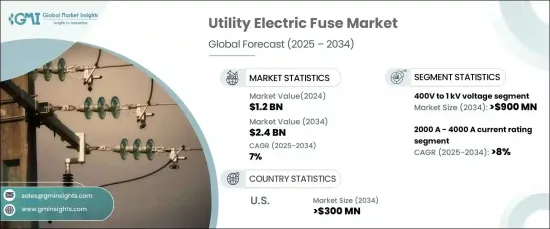 |
市場調查報告書
商品編碼
1667191
公用事業電氣保險絲市場機會、成長動力、產業趨勢分析與預測 2025 - 2034Utility Electric Fuse Market Opportunity, Growth Drivers, Industry Trend Analysis, and Forecast 2025 - 2034 |
||||||
2024 年全球公用事業電熔斷器市場價值為 12 億美元,將實現顯著成長,預計在 2025 年至 2034 年期間將實現 7% 的強勁複合年成長率。隨著工業化的快速發展和全球人口的成長推動電力需求,公用事業公司正在加大配電網路的開發和建設力度,以滿足不斷變化的需求。

受城市化、工業成長和電力基礎設施擴張的推動,400V 至 1kV 的電壓範圍預計到 2034 年將產生 9 億美元的收入。對再生能源(如太陽能和風能)的日益依賴(通常在此電壓範圍內運作)進一步放大了該領域的潛力。此外,採用提供即時監控、遠端診斷和自動故障檢測的智慧保險絲技術增強了先進保險絲解決方案在這一領域的吸引力。
| 市場範圍 | |
|---|---|
| 起始年份 | 2024 |
| 預測年份 | 2025-2034 |
| 起始值 | 12億美元 |
| 預測值 | 24億美元 |
| 複合年成長率 | 7% |
預計額定電流為 2000A 至 4000A 的保險絲在 2025 年至 2034 年期間的複合年成長率將達到 8%。這些大電流保險絲對於保護高壓設備和確保一致的電力分配至關重要。它們還保護變電站、變壓器和大型工業系統等重要基礎設施免受故障和過載的影響,在支持電網彈性和能源可靠性方面發揮關鍵作用。
預計到 2034 年,美國公用事業電保險絲市場規模將達到 3 億美元,主要得益於電網升級、再生能源整合和能源技術進步方面的大量投資。交通運輸的快速電氣化,特別是電動車(EV)的日益普及,進一步推動了對耐用、高效保險絲解決方案的需求。這些保險絲對於保護電動車充電系統和相關電力基礎設施至關重要,可確保無縫、安全的能量傳輸。
目錄
第 1 章:方法論與範圍
- 市場定義
- 基礎估算與計算
- 預測計算
- 資料來源
- 基本的
- 次要
- 有薪資的
- 民眾
第 2 章:執行摘要
第 3 章:產業洞察
- 產業生態系統分析
- 監管格局
- 產業衝擊力
- 成長動力
- 產業陷阱與挑戰
- 成長潛力分析
- 波特的分析
- 供應商的議價能力
- 買家的議價能力
- 新進入者的威脅
- 替代品的威脅
- PESTEL 分析
第4章:競爭格局
- 介紹
- 戰略儀表板
- 創新與永續發展格局
第 5 章:市場規模與預測:按電壓,2021 – 2034 年
- 主要趨勢
- 400V 至 1kV
- 1kV 至 11kV
- 11kV 至 33kV
- >33千伏
第 6 章:市場規模與預測:按當前評級,2021 年至 2034 年
- 主要趨勢
- 2000-4000A
- >4000安
第 7 章:市場規模及預測:按地區,2021 – 2034 年
- 主要趨勢
- 北美洲
- 美國
- 加拿大
- 墨西哥
- 歐洲
- 英國
- 法國
- 德國
- 義大利
- 荷蘭
- 亞太地區
- 中國
- 日本
- 印度
- 韓國
- 中東和非洲
- 沙烏地阿拉伯
- 阿拉伯聯合大公國
- 土耳其
- 拉丁美洲
- 巴西
- 阿根廷
第8章:公司簡介
- ABB
- Bel Fuse
- Denco Fuses
- Eaton
- Enerlux Power
- Fuji Electric
- General Electric
- Hiitio New Energy
- L&T Electrical & Automation
- Littelfuse
- Mersen
- S&C Electric
- Schneider Electric
- SIBA
The Global Utility Electric Fuse Market, valued at USD 1.2 billion in 2024, is set for remarkable growth, projected to achieve a robust CAGR of 7% from 2025 to 2034. This expansion is fueled by the increasing demand for reliable electricity, in line with a worldwide push to modernize power infrastructure. With rapid industrialization and a growing global population driving electricity needs, utilities are ramping up the development and enhancement of power distribution networks to meet these evolving demands.

The voltage range of 400V to 1kV is forecasted to generate $900 million by 2034, driven by urbanization, industrial growth, and the expansion of electrical infrastructure. The increasing reliance on renewable energy sources, such as solar and wind power-often operating within this voltage range-further amplifies the segment's potential. Additionally, the adoption of smart fuse technologies offering real-time monitoring, remote diagnostics, and automated fault detection enhances the appeal of advanced fuse solutions in this segment.
| Market Scope | |
|---|---|
| Start Year | 2024 |
| Forecast Year | 2025-2034 |
| Start Value | $1.2 Billion |
| Forecast Value | $2.4 Billion |
| CAGR | 7% |
Fuses rated for 2000A to 4000A are anticipated to witness a robust CAGR of 8% from 2025 to 2034. This growth aligns with global efforts to modernize power grids and transition toward renewable energy. These high-current fuses are critical in protecting high-voltage equipment and ensuring consistent power distribution. They also safeguard essential infrastructure, including substations, transformers, and large-scale industrial systems, against faults and overloads, playing a pivotal role in supporting grid resilience and energy reliability.
The U.S. utility electric fuse market is projected to reach USD 300 million by 2034, driven by significant investments in grid upgrades, renewable energy integration, and advancements in energy technologies. The rapid electrification of transportation, particularly the increasing adoption of electric vehicles (EVs), is further fueling demand for durable and efficient fuse solutions. These fuses are essential for protecting EV charging systems and associated power infrastructure, ensuring seamless and safe energy transfer.
Table of Contents
Chapter 1 Methodology & Scope
- 1.1 Market definitions
- 1.2 Base estimates & calculations
- 1.3 Forecast calculation
- 1.4 Data sources
- 1.4.1 Primary
- 1.4.2 Secondary
- 1.4.2.1 Paid
- 1.4.2.2 Public
Chapter 2 Executive Summary
- 2.1 Industry 3600 synopsis, 2021 - 2034
Chapter 3 Industry Insights
- 3.1 Industry ecosystem analysis
- 3.2 Regulatory landscape
- 3.3 Industry impact forces
- 3.3.1 Growth drivers
- 3.3.2 Industry pitfalls & challenges
- 3.4 Growth potential analysis
- 3.5 Porter's analysis
- 3.5.1 Bargaining power of suppliers
- 3.5.2 Bargaining power of buyers
- 3.5.3 Threat of new entrants
- 3.5.4 Threat of substitutes
- 3.6 PESTEL analysis
Chapter 4 Competitive Landscape, 2024
- 4.1 Introduction
- 4.2 Strategic dashboard
- 4.3 Innovation & sustainability landscape
Chapter 5 Market Size and Forecast, By Voltage, 2021 – 2034 (USD Million, ‘000 Units)
- 5.1 Key trends
- 5.2 400V to 1 kV
- 5.3 1 kV to 11kV
- 5.4 11kV to 33kV
- 5.5 > 33kV
Chapter 6 Market Size and Forecast, By Current Rating, 2021 – 2034 (USD Million, ‘000 Units)
- 6.1 Key trends
- 6.2 2000-4000A
- 6.3 > 4000A
Chapter 7 Market Size and Forecast, By Region, 2021 – 2034 (USD Million, ‘000 Units)
- 7.1 Key trends
- 7.2 North America
- 7.2.1 U.S
- 7.2.2 Canada
- 7.2.3 Mexico
- 7.3 Europe
- 7.3.1 UK
- 7.3.2 France
- 7.3.3 Germany
- 7.3.4 Italy
- 7.3.5 Netherlands
- 7.4 Asia Pacific
- 7.4.1 China
- 7.4.2 Japan
- 7.4.3 India
- 7.4.4 South Korea
- 7.5 Middle East & Africa
- 7.5.1 Saudi Arabia
- 7.5.2 UAE
- 7.5.3 Turkey
- 7.6 Latin America
- 7.6.1 Brazil
- 7.6.2 Argentina
Chapter 8 Company Profiles
- 8.1 ABB
- 8.2 Bel Fuse
- 8.3 Denco Fuses
- 8.4 Eaton
- 8.5 Enerlux Power
- 8.6 Fuji Electric
- 8.7 General Electric
- 8.8 Hiitio New Energy
- 8.9 L&T Electrical & Automation
- 8.10 Littelfuse
- 8.11 Mersen
- 8.12 S&C Electric
- 8.13 Schneider Electric
- 8.14 SIBA









